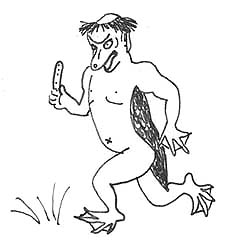|
||
 |
||

(C)2001 Japanese Architecture and Art Net Users System. No reproduction or republication without written permission.
掲載のテキスト・写真・イラストなど、全てのコンテンツの無断複製・転載を禁じます。
|
||||||
| kappa 河童 | ||||||
| KEY WORD : art history / paintings | ||||||
| Lit. river child. A supernatural water-sprite believed
to inhabit Japan's lakes and rivers. The name kappa varies from region
to region, and includes kawatarou 河太郎, kawako 河伯, and kawaranbe
河ランベ. The appearence of a kappa also varies, but kappa are generally thought
to be about the size of a young boy, and covered with green scales. They also
have a snout, bobbed hair, and a saucer-like depression on the top of the head
that holds water. When this water supply diminishes, the kappa's special
powers diminish. Kappa swim well thanks to webbed feet and hands, but can
also walk on land. Kappa also can rotate their arm and leg joints fully.
Some kappa resemble otters, turtles with beaks, or have wings. Kappa
are said to be fond of cucumbers and of sumou 相撲 wrestling. In some regions
kappa are thought to be helpful, but generally their reputation is far
more malicious. In particular, kappa delight in abducting humans and horses. Kappa
are noted for their aversion to metal objects. Illustrations of kappa frequently
are included in Edo period anthologies of supernatural tales. Kappa are
often depicted in comical paintings *giga
戯画 in paintings accompanying verse (see *haiga
俳画), and occasionally appear in *ukiyo-e
浮世絵 . |
||||||
 |
||||||
| REFERENCES: | ||||||
| EXTERNAL LINKS: | ||||||
| NOTES: | ||||||
(C)2001 Japanese Architecture and Art Net Users System. No reproduction or republication without written permission. 掲載のテキスト・写真・イラストなど、全てのコンテンツの無断複製・転載を禁じます。 |
||||||